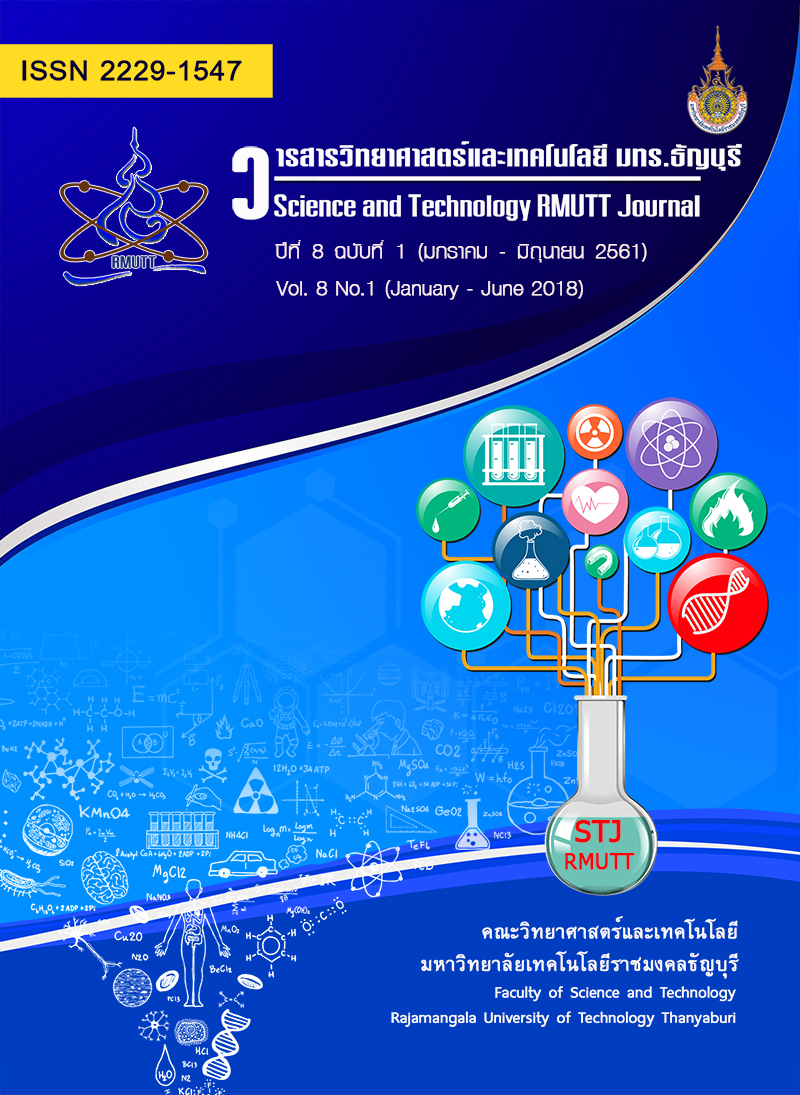Biopolymer from shrimp shell and lotus leaves for heavy metal removal in waste water
Main Article Content
Abstract
In this research project, the preparation of biopolymer from shrimp shell and lotus leaves for heavy metal removal in wastewater was studied. The optimum condition for metal removal was investigated. The parameters that effect on the preparation of adsorbent consists of the ratio between chitosan from shrimp, tannin from lotus leaves and glutaldehyde was conducted. The results shown the optimum ratio between weight of chitosan and tannin was 1:2 and the concentration of glutaldehyde was 5 percent. The metal adsorption efficiency of prepared adsorbent was tested. The maximum adsorption efficiency of lead (Pb) was found. The optimum condition for Pb removal was 175 milligram per liter of Pb in synthetic wastewater, initial pH of solution at 6, 0.2 gram of adsorbent, adsorption time of 30 minutes. With the optimum condition, the Pb removal efficiency from wastewater with biopolymer from shrimp and lotus leaves adsorbent as 16 milligram per gram of adsorbent. The FT-IR spectra of adsorbent that prepared from the reaction between biopolymer from shrimp and lotus leaves extract before and after metal adsorption were investigated to explore the position of functional groups available for the binding of metal onto adsorbent. From the results, a new adsorbent that prepared from biopolymer from shrimp shell and lotus leaves can used for Pb removal from waste water.
Article Details
References
A. Demirbas, Journal of Hazardous Materials 2008, 157, 220-229.
A. P. Lim and A. Z. Aris, Reviews in Environmental Science and Bio-Technology 2014, 13, 163-181.
G. Crini, Progress in Polymer Science 2005, 30, 38-70.
K. Maculotti, I. Genta, P. Perugini, M. Imam, A. Bernkop-Schnurch and F. Pavanetto, Journal of Microencapsulation 2005, 22, 459-470.
J. Sanchez-Martin, J. Beltran-Heredia and P. Gibello-Perez, Chemical Engineering Journal 2011, 168, 1241-1247.
J. B. Heredia and J. S. Martin, Journal of Hazardous Materials 2009, 165, 1215-1218.
Y. Y. Shen, R. L. Yang, Y. Liao, J. Ma, H. Mao and S. L. Zhao, Desalination and Water Treatment 2016, 57, 18529-18536.
Y. S. Ho, Industrial & Engineering Chemistry Research 2004, 43, 6265-6265.
S. V. Shilova, K. A. Romanova, Y. G. Galyametdinov, A. Y. Tret'yakova and V. P. Barabanov, Russian Journal of Physical Chemistry A 2016, 90, 1181-1184.
J. Naser. and S. 0rehZ., ScientificWorldJournal 2012, 2012, 793-606.
H. Ucun, Y. K. Bayhan, Y. Kaya, A. Cakici and O. F. Algur, Desalination 2003, 154, 233-238.
R. Ayyappan, A. C. Sophia, K. Swaminathan and S. Sandhya, Process Biochemistry 2005, 40, 1293-1299.
N. Friis and P. Myers-Keith, Biotechnol Bioeng 1986, 28, 21-28.
Y. Wang, F. Wang, T. Wan, S. Cheng, G. Xu, R. Cao and M. Gao, Journal of Wuhan University of Technology-Mater. Sci. Ed. 2013, 28, 650-657.


